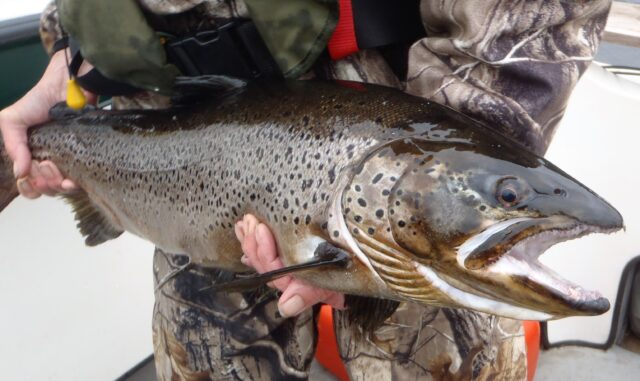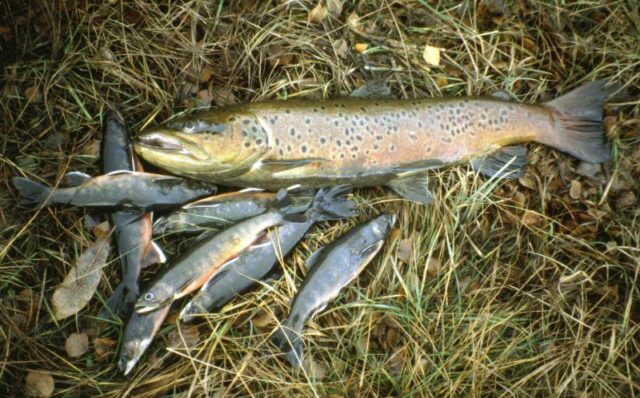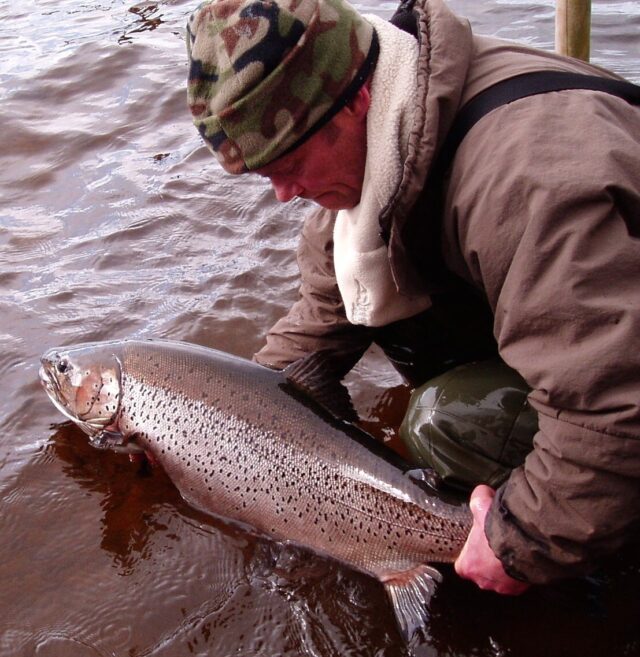Ferox trout are a fantastic example of the genetic diversity that exists within wild brown trout. Since the term ferox was first coined in 1835 by the renowned angler scientist Sir William Jardine, various authors have attempted to define what exactly a ferox is, for example:
Ferox are long-lived, late-maturing, piscivorous brown trout which in Britain and Ireland, are often present in large, deep glacier-formed lakes containing Arctic charr or whitefish species
The status of ferox within the brown trout (Salmo trutta) species complex epitomises the debate about what is and what isn’t a species (see Ferguson, 2004). There can be no doubt however that ferox can be spectacularly different from other brown trout; in life history, genetics and habits.
Catch & release of ferox trout: A video produced by Ferox 85; a dedicated group of ferox biologists:
Where are ferox found?
Ferox trout are found throughout the brown trout’s native range, wherever there are large glacial lakes. They are found mainly in Scotland, the Republic of Ireland and Northern Ireland but there are also thought to be populations in some Welsh lakes and in the English Lake District. In Campbell’s (1979) study, ferox were mainly found in lochs of over 100 ha with Arctic charr present, however ferox do occasionally occur in smaller lochs such as the 20ha Loch Bhrotain in Inverness. It was estimated that Ferox are present in less than 10% of sites in Scotland, given the thousands of sites where brown trout occur. The limited distribution of ferox, their apparent low density in the lakes that they do inhabit suggests a level of scarcity and vulnerability of populations.

Ferox Biology and Habits
While all young trout feed chiefly on invertebrates (benthivores) when young, the availability of other species of fish in a range of sizes, usually found in large lakes, provide an opportunity for trout to move to an almost entirely piscivorous (fish) based) diet.
The relationship between ferox and their prey is size-related rather than age-related and has a dramatic effect on ferox growth (Mangel & Abrahams, 2001); one tagging study recorded one ferox that increased in weight by 10lb (4.5 kg) in 4 years! Ferox living in the cold, nutrient-poor lochs can be much slower growing, but may also be long-lived (a 23-year-old fish from Loch Killin, Inverness being the oldest on record).
Some ferox populations have also been found to be older when they mature compared to other trout, which allows ferox to increase in size before they divert resources into spawning. This differing life-history strategy, combined with their protein-rich diet, translates into much larger sizes than the average brown trout angler will ever encounter. The current British rod-caught record is a 14.4 kg (31.7lb) fish from Loch Awe, Scotland, a renowned ferox loch. Experimental studies (Hughes et. al., 2016b), have shown that progeny of ferox trout (from Loch Ewe) are more aggressive, acquire better feeding territories and are able to grow more quickly than progeny of benthiverous trout of a similar size from the same loch.
Tagging work on ferox in Perthshire has found that ferox will move over a wide area, probably searching out shoals of baitfish such as Arctic charr, but may also switch diets as other opportunities arise, such as a salmon smolt run. A radio-tracking study found ferox making dives down to 30 metres, possibly in pursuit of charr, suggesting that ferox are active pursuit predators as opposed to ambush predators that use cover to attack prey.
Arctic charr are of great importance to ferox diet in most Scottish lochs. Where present (for example in Loch Lomond), whitefish species (coregonids) can form the main prey item of ferox. In lochs where no charr or whitefish are present other species including brown trout or perch may form the bulk of the ferox diet. Ferox have also been found to be able to switch diets. In Lough Corrib (Ireland), in recent times ferox have switched from a charr- to a roach-dominated diet following the extinction of charr after the introduction of the roach.

However, it is not entirely unknown for ‘normal’ brown trout to shift to a fish diet, or grow to large sizes for that matter. So how are ferox different?
Genetics
This is a complex area, particularly as Salmo trutta display large genetic variations and the debate about what does, or does not, determine a separate species continues amongst taxonomists. Scientific opinion has long been divided over the status of ferox as a separate species from brown trout. Modern techniques have studied the genetics, morphology, diet and life-history of ferox which have revealed some fascinating insights into the diversity that exists.
All ferox, brown trout and charr populations reflect the complexity of pre and post ice age (10 – 15,000 years ago) colonisations as ice cover ebbed and flowed over the landscape. For example, studies on Lough Melvin (Northern Ireland) have identified three distinct forms of brown trout: sonaghen, gillaroo and ferox; these forms are genetically distinct from each other and are likely to have remained so since colonising the lough from separate refuge areas. They have remained distinct by spawning in different locations and adopting different feeding habits. Indeed, ferox in Lough Melvin in Ireland and Lochs Awe and Laggan in Scotland have been found to be genetically more similar to each other than to other (non-ferox) trout in the same lakes. Initial studies have suggested that the ferox of Loughs Mask, Corrib and Erne also have the same genetic characteristics as Melvin ferox. This suggests a common ‘ancestral’ ferox lineage which colonised these waters after the last glacial retreat.
Some brown trout that do not have this ancestral genetic lineage also display ferox type characteristics. A study of fish-eating brown trout in three different lochs in Scotland found different life-history traits.
In Loch Awe the ferox are genetically distinct from other trout in Loch Awe. They began feeding on other fish at an earlier life-stage (one or two years of age) compared to the other two populations of ferox studied in Loch Rannoch and Loch na Sealga which are not genetically distinct from other trout. The combination of genetics and environment (as demonstrated by ferox trout in Loch Awe) suggest that ferox with ‘ancestral lineage’ are more efficient at acquiring food in a quantity and/or quality as juveniles than trout that spend longer as a benthivore. These studies provide evidence of higher dominance levels in ferox trout progeny that help to maintain the distinct life-history characteristics of ferox trout. There may be a level of inheritance of life history strategy present in some ferox populations. This suggestion is supported by other studies on the origins and genetic differentiation of ferox brown trout from their counterparts.
The video below shows a hen ferox trout digging a redd (nest) prior to spawning, with male trout in attendance.
Video courtesy of Chris Conway and the Ness Fisheries Board.
More of Chris’s underwater videos of trout, including ferox, are available here.

Conservation
The International Union for the Conservation of Nature (IUCN) and the Freshwater Fish Specialist Group regard ferox as a separate species. Ferox is listed in the IUCN Red List of Threatened Species with its status being given as “Data Deficient”
Whether or not ferox are considered a distinct species, their low numbers (at least in Scottish lochs) and distinct genetic characteristics (as in Loch Melvin) warrant enhanced conservation status. Large, predatory fish like this are prized by anglers yet only a tiny proportion of the trout in a loch are ferox; the ferox trait is therefore valuable and rare. There is some justification in the call for ferox to be accorded species status rather than the less valued (in an EU context) sub-species status. This echoes calls by researchers for effective conservation of brown trout to be based on genetic differences between populations. Threats to ferox trout include:
Overfishing
Tag-and-release studies in Loch Rannoch suggest that ferox densities in these nutrient-poor lochs are likely to be low. Even low intensity ferox angling therefore has the capacity to impact on ferox numbers. Catch-and-release is therefore of utmost importance and the same studies suggested that angling mortality is acceptably low. Because of their longevity, the impact of exploitation is likely to be greater than it would be for a shorter loved species.
Spawning tributaries
Spawning areas for ferox may be fairly specific and limited. In Lough Melvin, ferox achieve reproductive isolation by spawning in a single, deep river. Obstructions can block access to spawning tributaries. Outflow dams on Lochs Rannoch and Laggan may have negatively impacted on ferox recruitment. In Scandinavia, a number of studies before and after hydropower development have been carried out and are fairly applicable to the British Isles. In upland areas, intensive commercial forestry can also severely limit primary productivity in streams and increase acidity to dangerous levels during peak flood events.
Introduced species
In relatively pristine post-glacial fish communities like Lough Melvin in Ireland, ferox hold the top predator position. Introduction of pike in these lakes could lead to the replacement of ferox as the top predator. Pike and ferox co-exist in Loch Awe and more study is needed into the relationship between these top predators. Potentially more serious is the introduction of the filter feeding zebra mussels into Lough Melvin. These are highly efficient filter feeders and their introduction could have disastrous effects on the lakes native planktivores (e.g. sonaghen trout and charr) that ferox rely on. Ferox are adapted open water pelagic predators. The replacement of charr for example by littoral or benthic feeding fish could therefore have unforeseen consequences for ferox — again, a precautionary approach and more research is needed.
Stocking
The dangers of stocking fertile, hatchery-bred fish are well documented elsewhere on this website. Stocking could threaten the genetic integrity of the ferox stock and reduce or alter ferox characteristics. Supportive breeding schemes (using brood-stock from the wild) also pose a threat through inadvertent crossing of genetically distinct forms of trout.
Further information
Click the following links for other useful information on ferox biology & conservation:
- Ferox Trout information sheet – Fisheries Research Services Scotland.
- Ferox trout: A Predator worthy of Pursuit and Protection: proceedings of the 2002 ISACF meeting in Ireland, hosted by the Irish Charr Conservation Group
- Summary: The Movements of Ferox Trout, Salmo trutta, in a Scottish Highland Freshwater Loch
- Ferox Research at Glasgow University, Facebook page: https://www.facebook.com/feroxproject
This page has been compiled with the kind assistance of Dr. Ron Greer, Dr Alan Kettle-White and Professor Andy Ferguson. Photographs courtesy of Alan Kettle-White, Aya Thorne and David Greenwood.

Academic references
Campbell, R. N. Ferox trout, Salmo truttaL., and charr, Salvelinus alpinus (L.), in Scottish lochs. Journal of Fish Biology 14, 1 – 29 (1979).
Cawdery, S. A. . & Ferguson, A. Origins and differentiation of three sympatric species of trout (Salmo trutta) in Lough Melvin. Polskiie Archiwum Hyrdobiologii 35, 267 – 277 (1988).
Duguid, R.A., Ferguson, A. & Prodohl, P. Reproductive isolation and genetic differentiation of ferox trout from sympatric brown trout in Loch Awe and Loch Laggan, Scotland. Journal of Fish Biology 69, 89 – 114 (2006).
Ferguson, A. The Importance of Identifying Conservation Units: Brown Trout and Pollan Biodiversity in Ireland. Biology & Environment: Proceedings of the Royal Irish Academy 104, 33 – 41 (2004).
Ferguson, A. & Taggart, J. B. Genetic differentiation among the sympatric brown trout (Salmo trutta) populations of Lough Melvin, Ireland. Biological Journal of the Linnean Society 43, 221 – 237 (1991).
Greer, R. B., Thorne, A. & Macdonald, A. Ferox trout : A Predator worthy of Pursuit and Protection. Proc. 2002 ISACF meeting (2002).
Greer, R.B. (1995). Ferox Trout & Arctic Charr; A predator, its pursuit & prey. Swanhill, Shrewsbury.
Grey, J., Thackeray, S., Jones, R. & Shine, A. Ferox Trout (Salmo trutta) as Russian dolls: complementary gut content and stable isotope analyses of the Loch Ness foodweb. Freshwater Biology47, 1235 – 1243 (2002). To view the paper, click here. (with kind permission of Dr. Jonathan Grey).
Grey, J. Ontogeny and dietary specialization in brown trout (Salmo trutta L.) from Loch Ness, Scotland, examined using stable isotopes of carbon and nitrogen. Ecology of Freshwater Fish 2001: 10: 168 – 176. To view the paper click here (with kind permission of Dr. Jonathan Grey).
Hardie, R.P. Ferox and Char Parts I and II, Coch-y-Bonddu Books, Machynlleth (re-print of Part I first published 1940 and recently discovered manuscript of Part II).
M. R. Hughes, J. A. Dodd, P. S. Maitland and C. E. Adams (2016a). Lake bathymetry and species occurrence predict the distribution of a lacustrine apex predator. Journal of Fish Biology (2016) doi:10.1111/jfb.12919
M. R. Hughes, T. E. Van Leeuwen, P. D. Cunningham and C. E. Adams (2016b). Parentally acquired differences in resource acquisition ability between brown trout from alternative life history parentage. Ecology of Freshwater Fish (2016) doi: 10.1111/eff.12323
M. R. Hughes, O. Hooker, T. E. Van Leeuwen, A. H. Kettle-White, A. Thorne, P. Prodohl and C. E. Adams (2016c). Contrasting growth trajectories between sympatric S. trutta exhibiting alternative life history strategies. Ecology of Freshwater Fish (2016) doi: 10.1111/eff.12323
Mangel, M. & Abrahams, M.V. Age and longevity in fish, with consideration of the ferox trout. Experimental Gerontology 36, 765 – 790 (2001).